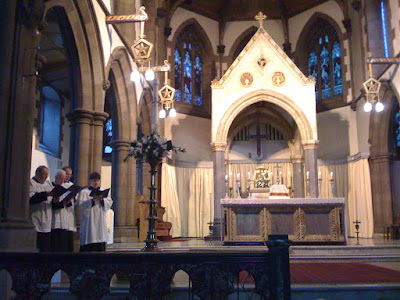Popule meus, quid feci tibi? Aut in quo contristavi te? Responde mihi. V. Quia eduxi te de terra Ægypti: parasti Crucem Salvatori tuo.
O my people, what have I done to thee? or wherein have I afflicted thee? Answer me. V. Because I led thee out of the land of Egypt, thou hast prepared a cross for thy Savior.
The two choirs then sing alternately:
Hagios o Theos.
Sanctus Deus.
Hagios Ischyros.
Sanctus Fortis.
Hagios Athanatos, eleison hymas.
Sanctus Immortalis, miserere nobis.
The two choirs then sing alternately:
O holy God!
O holy God!
O holy strong One!
O holy strong One!
O holy immortal One, have mercy upon us.
O holy immortal One, have mercy upon us.
Two cantors:
Quia eduxi te per desertum quadraginta annis, et manna cibavi te, et introduxi in terram satis optimam: parasti Crucem Salvatori tuo.
Two cantors:
Because I led thee out through the desert forty years: and fed thee with manna, and brought thee into a land exceeding good, thou hast prepared a Cross for thy Savior.
Alternately the two choirs repeat as before: Hagios o Theos…
Alternately the two choirs repeat as before: O holy God!
Two cantors:
Quid ultra debui facere tibi, et non feci? Ego quidem plantavi te vineam meam speciosissimam: et tu facta es mihi nimis amara: aceto namque sitim meam potasti: et lancea perforasti latus Salvatori tuo.
Two cantors:
What more ought I to have done for thee, that I have not done? I planted thee, indeed, My most beautiful vineyard: and thou hast become exceeding bitter to Me: for in My thirst thou gavest Me vinegar to drink: and with a lance thou hast pierced the side of Thy Savior.
Alternately the two choirs repeat as before: Hagios o Theos…
Alternately the two choirs repeat as before: O holy God!
The verses of the following reproaches are sung alternately by two cantors of each choir. The choirs respond after each verse: Pópule meus... as far as the verse Quia.
Ego propter te flagellavi Ægyptum cum primogenitis suis: et tu me flagellatum tradidisti.
R. Popule meus, quid feci tibi? Aut in quo contristavi te? Responde mihi.
V. Ego te eduxi de Ægypto, demerso Pharaone in Mare Rubrum: et tu me tradidisti principibus sacerdotum.
R. Popule meus,…
V. Ego ante te aperui mare: et tu aperuisti lancea latus meum.
R. Popule meus,…
V. Ego ante te præivi in columna nubis: et tu me duxisti ad prætorium Pilati.
R. Popule meus,…
V. Ego te pavi manna per desertum: et tu me cecidisti alapis et flagellis.
R. Popule meus,…
V. Ego te potavi aqua salutis de petra: et tu me potasti felle et aceto.
R. Popule meus,…
V. Ego propter te Chananæorum reges percussi: et tu percussisti arundine caput meum.
R. Popule meus,…
V. Ego dedi tibi sceptrum regale: et tu dedisti capiti meo spineam coronam.
R. Popule meus,…
V. Ego te exaltavi magna virtute: et tu me suspendisti in patibulo Crucis.
R. Popule meus,…
The verses of the following reproaches are sung alternately by two cantors of each choir. The choirs respond after each verse: Pópule meus... as far as the verse Quia.
For thy sake I scourged Egypt with its first-born: and thou hast scourged Me and delivered me up.
R. O my people, what have I done to thee? or wherein have I afflicted thee? Answer me.
V. I led thee out of Egypt having drowned Pharao in the Red Sea: and thou hast delivered Me to the chief priests.
R. O my people...
V. I opened the sea before thee: and thou with a spear hast opened My side.
R. O my people...
V. I went before thee in a pillar of cloud: and thou hast led Me to the judgment hall of Pilate.
R. O my people...
V. I fed thee with manna in the desert; and thou hast beaten Me with blows and scourges.
R. O my people...
V. I gave thee the water of salvation from the rock to drink: and thou hast given Me gall and vinegar.
R. O my people...
V. For thy sake I struck the kings of the Chanaanites: and thou hast struck My head with a reed.
R. O my people...
V. I gave thee a royal scepter: and thou hast given to My head a crown of thorns.
R. O my people...
V. I exalted thee with great strength: and thou hast hanged Me on the gibbet of the Cross.
R. O my people...





























